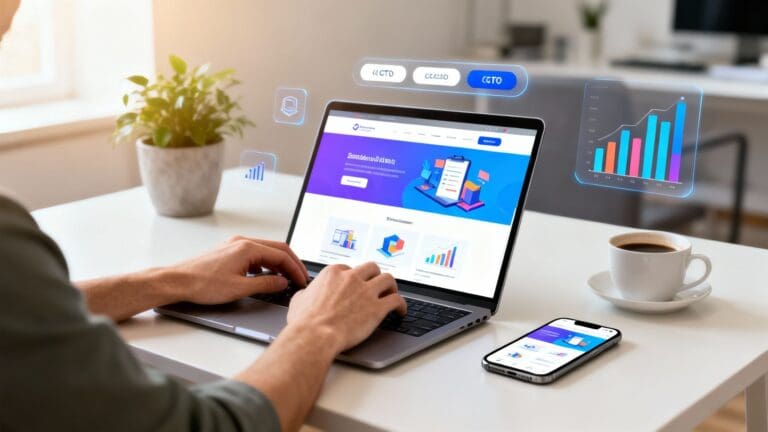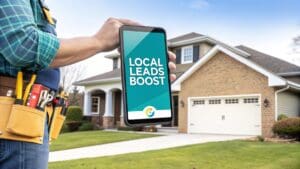Feeling like your business is the best-kept secret in town? Let's fix that. Getting a website doesn't mean you have to learn nerdy computer code. It’s like opening a new front door to your shop that never, ever closes. Your website is your first handshake with a new customer, and we’re going to make sure it’s a good one!
Your Digital Welcome Mat: A Website That Works for You
Think about it: when you need something, what’s the first thing you do? You grab your phone and search for it. Your customers are doing the same thing. A great website design for small business isn't a fancy extra anymore; it's as important as having a phone number. It shows people you're a real, professional business.
You don’t need some crazy, complicated site that costs a million bucks. Nope. Simple is almost always better. The goal is to build a digital welcome mat that works as hard as you do, answering questions and bringing in new customers while you're busy or even sleeping. Zzz-ching!
This guide cuts through all the confusing stuff. We'll skip the tech talk and give you a super simple plan to build a powerful tool for your business. You can totally do this. Let's go!
Your First Big Choice: Do It Yourself or Hire a Pro?
Okay, first decision. Are you going to build this thing yourself, or have someone do it for you? There's no wrong answer here! It just depends on if you have more time or more money, and how you feel about clicking around on a computer.
Don't worry, neither choice requires you to become a computer genius overnight.
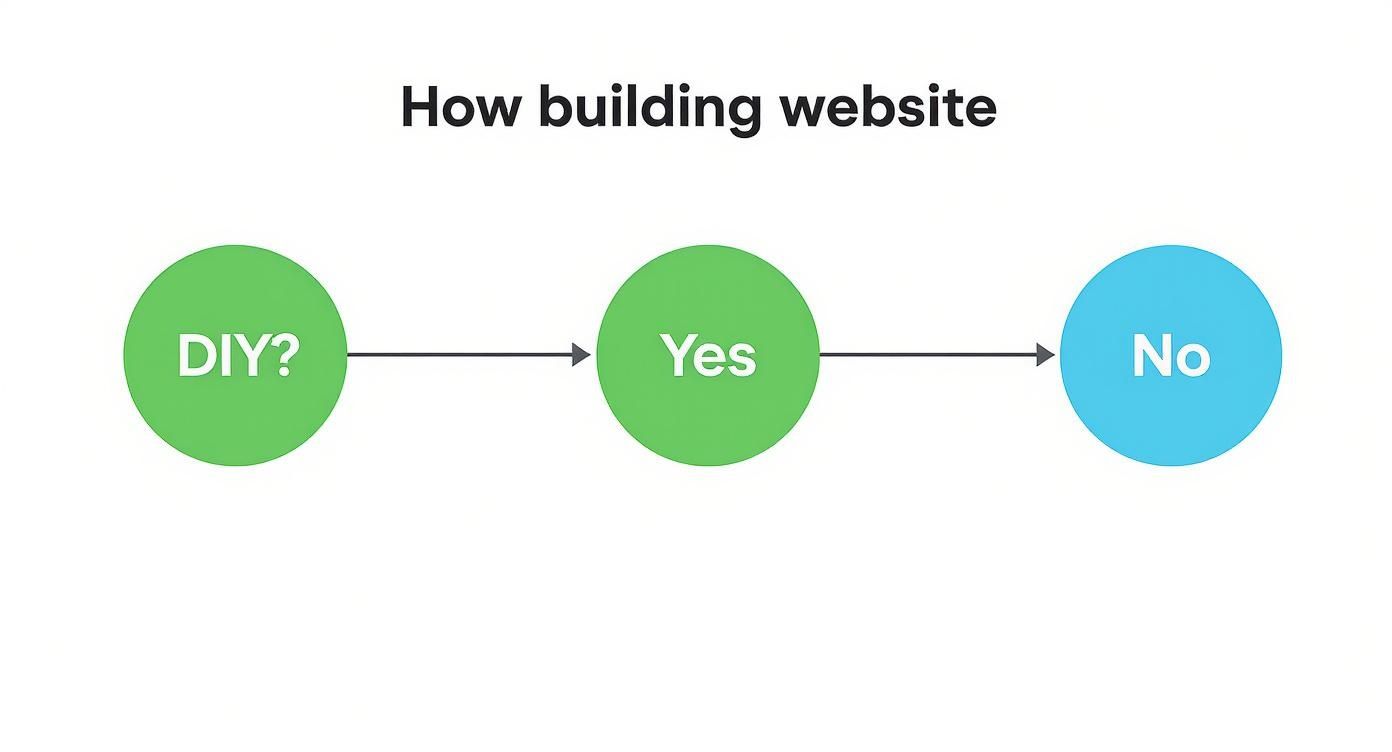
This is a big step, so let's look at your options in plain English. This will help you figure out what makes the most sense for you right now.
Website Options at a Glance: Which Way Should You Go?
| Method | Best For | Average Cost | Time to Launch |
|---|---|---|---|
| DIY Website Builder | Folks with more time than money; if you can use Facebook, you can use this. | $16 – $50/month | 1-4 weeks |
| Hire a Freelancer | A good middle choice if you want a custom look without a crazy price tag. | $1,000 – $5,000 | 3-6 weeks |
| Hire an Agency | Businesses ready to invest in a pro team to handle everything. | $5,000 – $15,000+ | 6-12+ weeks |
Choosing between doing it yourself, hiring a freelancer, or getting an agency really just depends on what you have to work with. A DIY site is fast and cheap, but having a pro build it can save you from future headaches and look a bit more polished. A whopping 73% of small businesses now have a website, so just getting online is a huge step!
Why a Simple Website Wins Every Time
It's tempting to want all the flashy bells and whistles, but the websites that actually make money are almost always the simple and clean ones. Your customers are busy. They want answers, and they want them fast. A simple, clean website design helps them find what they need without getting frustrated and leaving.
Your website is your best employee. It works 24/7, never calls in sick, and its only job is to turn visitors into customers. Let's make sure it's dressed for success.
The most important thing is being clear. Can a stranger understand what you do in five seconds? Is your phone number easy to find? Is there a big, obvious button that says "Get a Quote"? These are the little things that turn clicks into customers. For more ideas, check out these awesome Top 7 Website Design Tips for Small Business Success.
Designing a Site Customers Actually Enjoy Using
Have you ever landed on a website and felt totally lost? Like being dropped in a corn maze with no map. Yeah, that's what we want to avoid.
The best website isn't about fancy art or cool animations. It’s about making it super easy for a customer to find what they need—your phone number, your services, how to contact you—without getting annoyed. Think of your website as a friendly helper, not a hard math test.
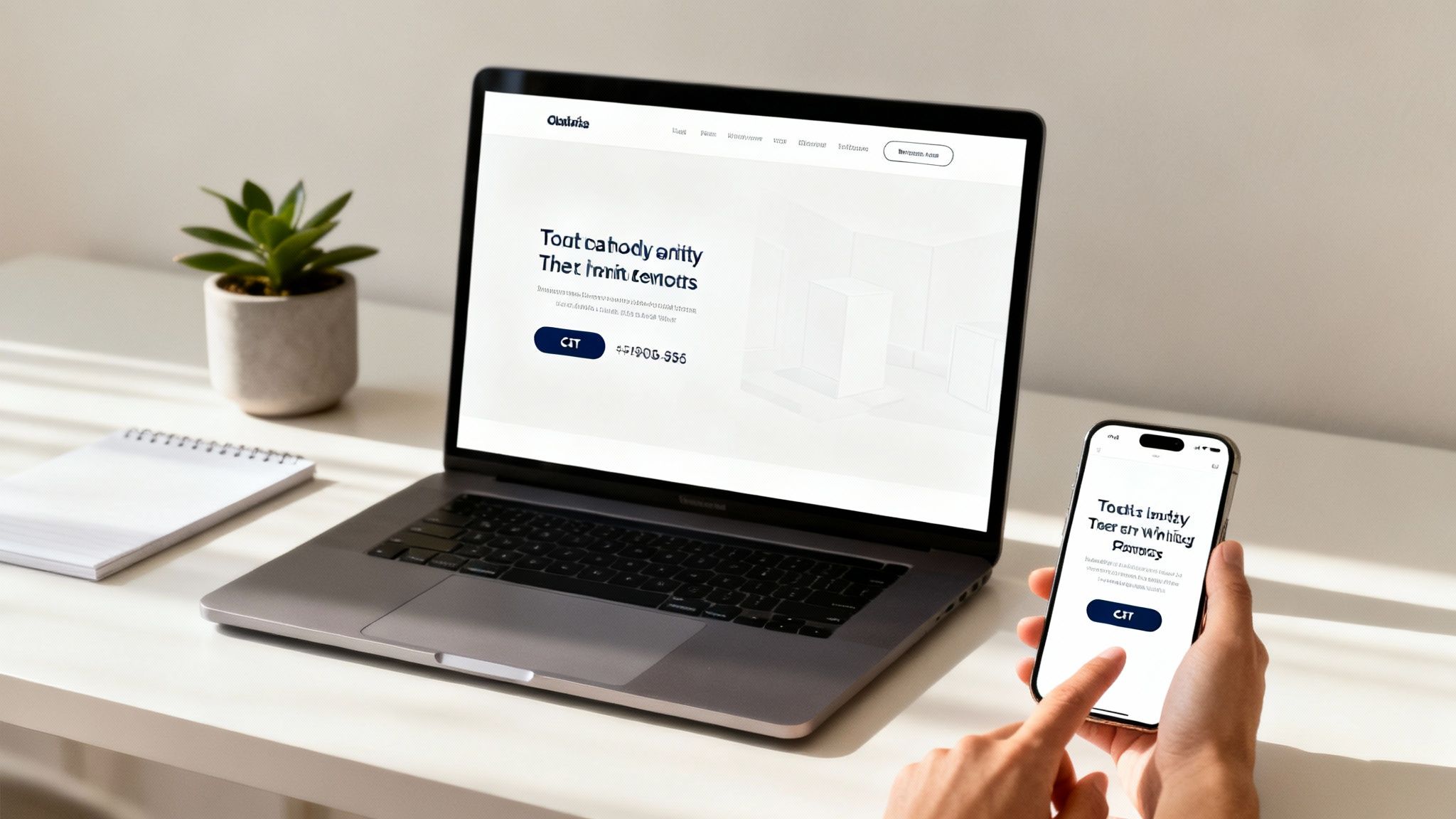
Put Yourself in Your Customer's Shoes
Here’s the biggest secret to great design: stop thinking like a business owner and start thinking like your customer. What's the very first thing they need when they get to your site? What problem are they trying to solve right now?
If someone's basement is flooding, they don't care about your company's long history. They need a phone number, and they need it five minutes ago. So put it right at the top, big and bold.
Thinking about your customer first should guide every single choice you make. It's the difference between a website that's just an online flyer and one that actually gets you more business.
Keep It Simple, Silly
There's a saying: "a confused mind always says no." Let's make that your new website motto. When it comes to your site, simple is smart. And more importantly, simple makes you money.
Throwing a dozen colors, five different fonts, and pop-ups all over the place is a great way to send people running to your competitor. Instead, use a clean look that lets your words and pictures do the talking.
Here are a few simple rules:
- Big, Obvious Buttons: Your "Get a Free Estimate" button should be impossible to miss. Don't make people hunt for it!
- Easy-to-Read Words: Use a clean, simple font. Make it big enough so people can read it on their phone without squinting.
- Use Real Photos: Cheesy stock photos look fake. Use real pictures of your team, your work truck, and your happy customers. It builds trust instantly.
When your design is clear, your message is clear. A simple design isn’t boring; it means you respect your customer's time.
And this isn't just my opinion. When people were asked what they like most on a site, a huge 71% said simple navigation was the most important thing. You can find more cool facts like that in these top web design statistics.
Design for Phones First, Not Last
Here’s a fact: most of your customers will find you on their phones. Not on a big computer, but on that little screen they carry everywhere. If your website looks like a scrambled mess on a phone, you're losing money. It's that simple.
There's a fancy term for this called responsive design. It just means a website that automatically changes its shape to fit any screen, big or small. Most modern website builders do this for you, but you should always check it yourself.
Pull up your website on your phone right now. Can you easily read the text? Can you tap the buttons without your thumb hitting three things at once? A bad phone experience is like having a "Closed" sign on your front door. We talk more about this in our guide on why you have to make sure your website is mobile-first.
Choosing Your Tools (Without the Headache)
The words "build a website" can sound scary, like you need to be a computer whiz. Forget that! Today’s tools are made for busy people like you, not tech nerds.
Think of modern website builders like digital LEGOs. You don’t need to know how to make the plastic bricks; you just snap them together. It's the same idea. You pick a look you like, drag your words and pictures where you want them, and you're good to go. You can do this!
What Is a Website Builder Anyway?
A website builder is an online tool that lets you create a professional website without writing a single line of code. You’ve probably heard their names: Wix, Squarespace, Shopify. They handle all the scary technical stuff so you can focus on what you do best.
Each one is a little different, but they all have the same goal: making website design for small business super easy. Your next step is just picking the right one for you.
Here's a look at the Wix editor. See how you can just click on the words or a picture to change it?
It’s all clicking and dragging. What you see is what you get. No secret codes needed!
Finding the Perfect Fit for Your Business
A local bakery needs a different website than a plumber. Let's look at the big players in plain English to see what might work for you.
-
For most service businesses (like contractors, cleaners, or consultants): A builder like Wix or Squarespace is usually the best place to start. They are flexible, super simple, and have tons of great-looking templates to get you started in minutes.
-
For businesses selling products (like jewelry, t-shirts, or crafts): Shopify is the king of selling stuff online. It was built to handle products, payments, and shipping without giving you a headache.
-
For businesses on a tight budget: Most builders have cheap plans to get you started. The trick is to find one that won’t charge you extra for every little thing. We made a guide that explains everything you need to know about small business website costs to help you figure it out.
Don't get stuck trying to pick the "perfect" tool. The best website builder is the one you actually use to get your site online. Pick one that feels good and get started. You can always change it later.
Tons of businesses use these tools—Wix alone powers nearly 45% of the market! But many businesses end up re-doing their sites because they don’t get enough customers from it (80.8%) or it’s hard to use (61.5%). This usually happens because they picked the wrong tool for the job. You can learn more about these small business website statistics and avoid being one of them.
Getting this choice right saves you a huge headache later. And if you’re staring at the options and feeling stuck, that’s what we’re here for! We can help you pick the right one and get back to work.
Building the Must-Have Pages for Your Website
Okay, you've picked your tools and you're ready to build. Now, what do you actually put on the website? It’s easy to overthink this, but the secret to a great small business website is to keep it simple.
Your website isn’t a fancy painting. It’s a tool. Its only job is to answer questions and get people to call you. That’s it.
Forget about building a huge site with dozens of pages. You only need four main pages to get started and get more customers. Let’s build them!
The Homepage: Your Digital Handshake
Your homepage is your welcome mat. When someone lands on it, they need to know what you do in about three seconds. If they can't figure it out, poof! They're gone. You just lost a customer.
This page has one job: make a great first impression that makes them want to learn more. Don't fill it with your entire life story or every photo you've ever taken. Keep it short and sweet.
Your homepage MUST answer these three questions right away:
- What do you do? (Example: “Emergency Plumbing in Your Town.”)
- Who is it for? (Example: “For homeowners who need fast, friendly repairs.”)
- What should I do next? (Example: A big, can't-miss-it button that says “Call Now for a Free Quote!”)
Get these three things right, and you’re already doing better than most of your competition.
The About Page: Where They Decide if They Like You
This isn't a boring history lesson. The About page is where you stop being just a company and start being a real person. People like doing business with other people they know, like, and trust.
Tell a quick story. Why did you start your business? What makes you excited to do what you do?
Most importantly, share a real photo of yourself or your team. A good picture from your phone is 100 times better than a cheesy stock photo. It shows you're a real local business and builds trust.
Don't be afraid to show some personality! Your About page is your chance to connect with people. It’s often the last page someone looks at before they decide to call you.
A simple story about why you love your job is way more powerful than a long list of awards.
The Services or Products Page: What You Actually Sell
Time to talk business. Explain what you offer in plain, simple English. Don't use fancy industry words that your customers won't understand.
If you're a painter, don't say "we apply exterior coatings." Say, "We paint houses, decks, and fences to make them look brand new." Use simple bullet points to show what's included.
- Use great photos of your actual work. No fake pictures!
- Group your services into simple categories.
- Put a clear button like "Get an Estimate" on every service description.
Being clear is everything. A confused customer will never buy from you. This is a super important part of any good website design for small business because this is where you make the sale.
The Contact Page: The Most Important Page of All
Seriously! The whole reason you have this website is to get more customers, right? So why do so many businesses make it hard to find their phone number?
Make it ridiculously easy for people to give you money.
Your Contact page must have:
- Your Phone Number: Big, bold, and easy to tap on a phone.
- Your Email Address: For people who like to write.
- A Simple Contact Form: Just ask for a name, email or phone, and a quick message. Don't make them write a novel.
- Your Business Address & a Map: Super important if you have a shop people need to find.
Putting these pages together doesn't have to be a huge project. You can get this done in an afternoon.
And if you get stuck or just want a pro to do it for you, that’s what we do! We help small businesses build simple websites that work, so your phone starts ringing more often.
Turning Website Visitors into Actual Customers
A pretty website is nice, but a website that makes your phone ring is way better. So far, we've built the main pages. Now, let's add the magic that turns those pages into a customer-getting machine.
The secret ingredient is called a Call to Action, or CTA. That’s just a fancy term for telling people what you want them to do next. It sounds simple, but it’s amazing how many websites forget to do this!
Having a beautiful website without a clear CTA is like opening a store but forgetting to put in a cash register. People might walk in, look around, and then leave because they don't know how to buy anything.
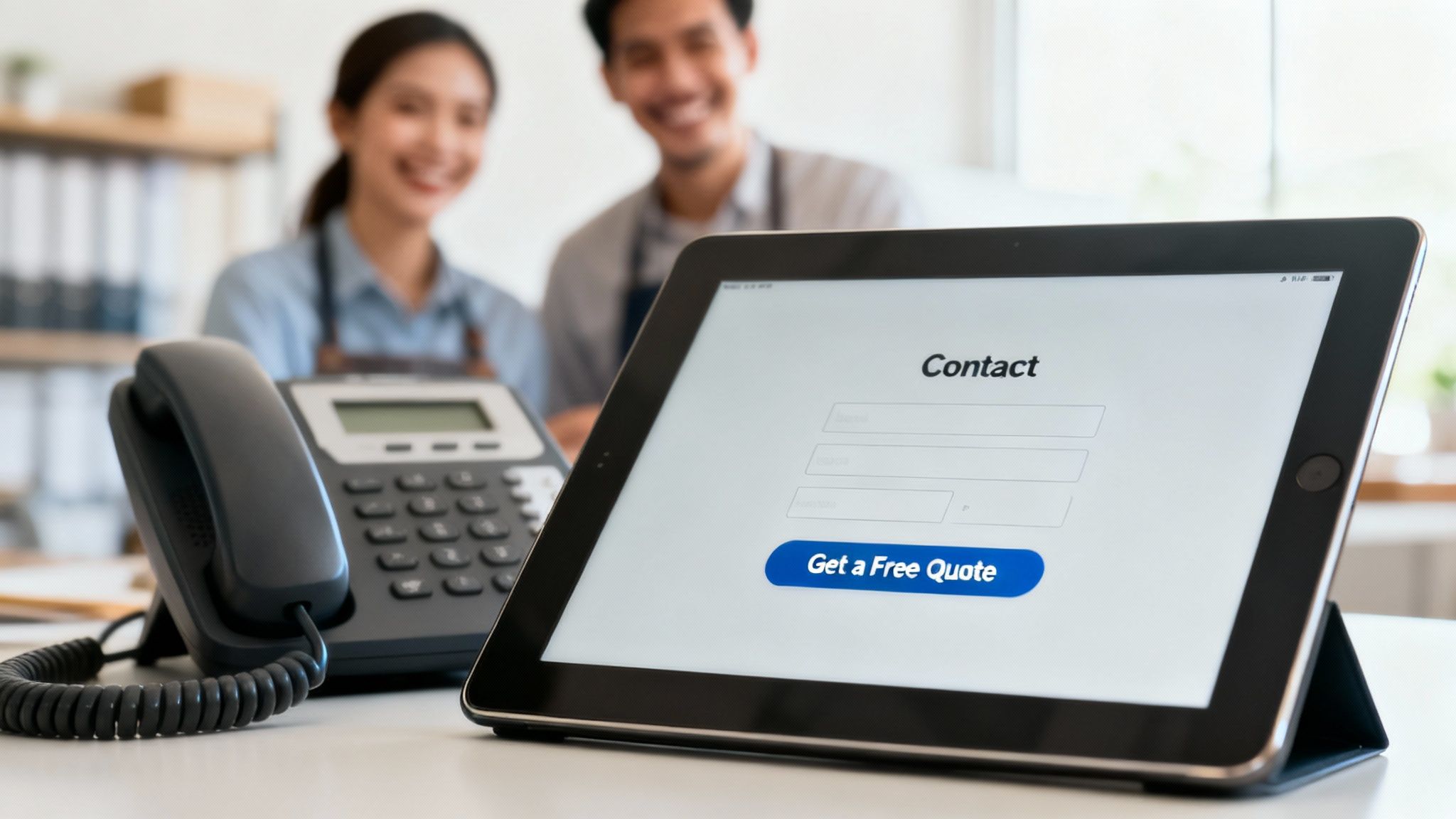
Making Your Buttons Pop
Your CTAs should be the most obvious things on every page. We’re talking about big, friendly buttons that you just can't miss. Don't be shy!
Think about the colors. If your whole website is blue and white, a bright orange or green button will jump right off the page. You want that button to yell, "Click me! I'm here to help!"
The words you use are just as important. Instead of a boring button that says "Submit," use action words that promise a good result.
Here are a few examples that work great:
- Get a Free Quote Now
- Schedule Your Free Visit
- Call Us for Emergency Help
- See Our Prices
See how they all start with a "doing" word? They tell people exactly what to do. That tiny change can make a huge difference in how many people contact you.
Put Your Phone Number Everywhere
For many local businesses, the main goal is a phone call. So, let’s make it super easy for people to call you. Your phone number should be at the top of every single page of your website.
Don't hide it on the contact page. Put it at the top, at the bottom, and all over your service pages.
And here’s a pro tip: make sure the number is a "click-to-call" link. That means when someone on their phone taps the number, it automatically opens their phone to call you. Easy peasy!
A visitor should never be more than one thumb-tap away from calling you. The easier you make it, the more calls you will get. It's that simple.
This whole process of guiding visitors is the key to turning your website into a tool that finds you new customers. If you want to learn more about this strategy, you can read about what lead generation marketing is and how it can help your business grow.
You Can Do This (And We Can Help)
Making good CTAs isn't some complicated trick. It’s just about thinking like your customer and making their life easier. It's about giving clear instructions.
You can go through your own site right now and make your CTAs better in less than an hour. Look at each page and ask yourself, "Is it totally clear what I want the visitor to do here?"
If the answer is no, add a big button or a bold phone number. These simple changes are what make your website start working for you. And if you’re feeling stuck or just want someone else to look at it, that’s why we’re here. We help small businesses make these small changes that bring in big results.
Launching Your Site and Getting Found on Google
Hooray! You hit the “publish” button. Your new website is live. That’s a huge deal! Pat yourself on the back. But pretty soon, you start to wonder… now what? Where are all the customers?
Getting your site live is like building a brand-new store. Now you have to unlock the doors and tell people you're open for business.
This is the part that feels like a big mystery to most people, but I promise it's simpler than you think. You don't need a marketing degree. It’s really just about telling people (and Google) that you exist and you're ready to help them.
Shouting It from the Rooftops
First things first: tell everyone you already know. Don't be shy. You just built an awesome new tool for your business, so show it off!
This is the easy stuff—the fastest way to get your first visitors.
Here are a few super simple things you can do right now:
- Tell your social media followers. Post a link on your Facebook, Instagram, or wherever you are online. Announce that your new digital home is open.
- Add the link to your email signature. Just like that, every email you send is a tiny ad for your website.
- Put it on your business cards and truck. Your website address should be on everything related to your business.
This gets the ball rolling. Now, let’s get you in front of people who don't know you… yet.
Making Friends with Google
This is where people start using scary-sounding words like SEO. Let’s make it simple.
SEO (Search Engine Optimization) is just making it really easy for Google to understand what your website is about. That's it. Think of Google as a giant library and your site as a new book. SEO is like giving your book a clear title and putting it on the right shelf so people can find it.
When someone in your town searches "plumber near me," Google’s only goal is to show them the best local plumber. Your job is to make it obvious to Google that you are that plumber. To get your site in front of local customers, you have to be good at local search. You can learn about local SEO strategies for small businesses to learn more.
Getting found on Google isn't about tricking a computer. It's about clearly explaining who you are, what you do, and where you do it. Simple as that.
You’ve already done most of the hard work by building clear pages about what you do. Now, it's about proving to Google that you're a real, local business. One of the best ways to do that is by signing up for a Google Business Profile (what used to be called Google Maps). It's 100% free and it tells Google you're a real business.
A Quick Peek Under the Hood
So how do you know if any of this is working? You don't have to be a numbers genius to figure it out. Most website builders have simple, built-in tools that show you the basics.
You can see stuff like:
- How many people visited your site this month.
- Which pages are the most popular.
- How people found you (like from a Google search or a Facebook link).
This isn't about getting lost in charts. It's about taking a quick look once a month to see what's working. If you see that tons of people are visiting your "Fence Painting" page, maybe you should add more pictures of your awesome fence work! It’s all about making small, smart changes over time.
Your website is a living part of your business, not something you do once and forget about. By launching it and telling people about it, you turn it from a simple online flyer into a machine that helps your business grow.
If SEO still feels like a lot, don't worry. We put together a simple guide to get you started. Check out our small business SEO checklist for easy steps. And if you ever need a hand, we're here to help you get found.
Quick Answers to Common Website Questions
Feeling stuck? You’re not the only one. Everyone has questions when they're building a website.
Here are the quick, simple answers to the questions we hear from business owners every single day.
Think of this as your cheat sheet to get past those last few worries. Let's get you unstuck and ready to go. You’ve got this!
How Much Does a Small Business Website Really Cost?
This is the big one! The cost can be anything from about $15 a month for a do-it-yourself builder like Wix or Squarespace to thousands of dollars if you hire a big company.
For most new businesses, starting with a simple, low-cost builder is the smartest move. It gets you online without spending a ton of money. Don't overthink it. Just get started!
Do I Need to Hire Someone for SEO?
Nope, not at first. You can totally handle the basics yourself.
Things like using clear page titles ("Our Plumbing Services in Your Town"), describing what you do in simple words, and getting your business listed on Google Maps—that's SEO. You can do that.
The best SEO is just being helpful. Focus on a website that clearly answers your customers' questions. Google loves that.
You don't need to be a tech wizard. Just be clear and helpful.
How Long Will It Take to Build My Website?
With today's website builders, you can have a simple, professional-looking site live in a single weekend. I'm serious!
The secret is to keep it simple. Get the most important pages up and running. You can always add more stuff later as your business grows. The goal is to get it done, not to make it perfect. Get it launched!
What's the Most Important Thing on My Homepage?
Your phone number and a clear instruction of what to do next. That’s it.
Within five seconds, a visitor needs to know exactly what you do and how to hire you.
Make your phone number huge. Put a big, friendly button on the page that says something like "Get a Free Estimate." Everything else is less important than that one mission: making it super easy for a customer to call you.
Ready to turn these answers into a website that actually makes your phone ring? At The Cherubini Company, we've spent over 25 years helping businesses in Ohio and beyond build simple, powerful websites that work as hard as they do. If you want to get found online and get more jobs, we're here to help. Let's build something great together.

